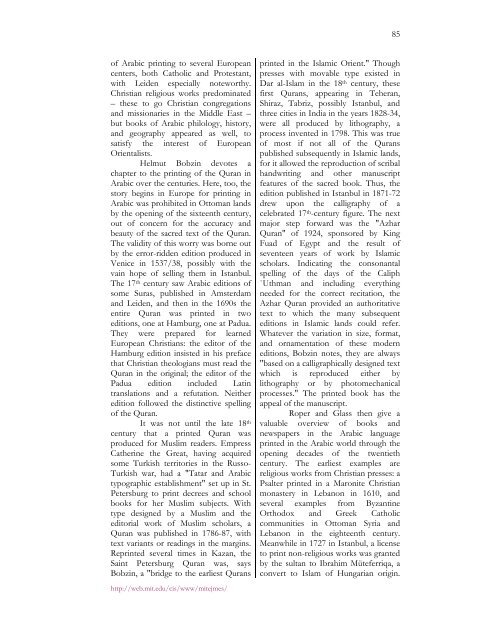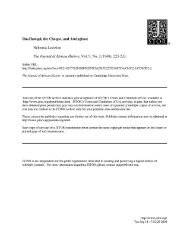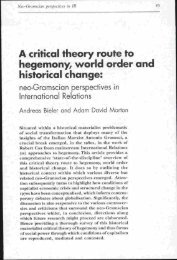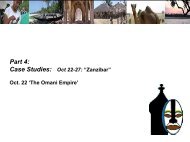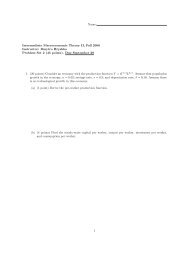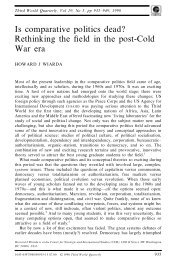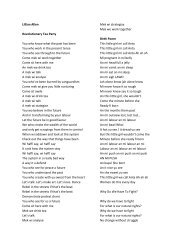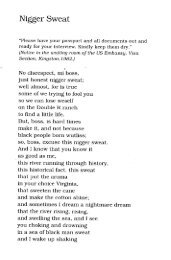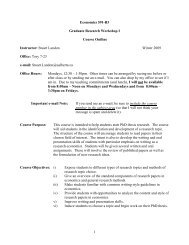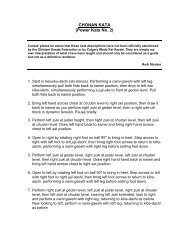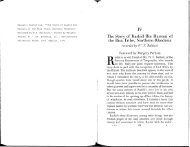personal memories revolutionary states and indian ocean migrations
personal memories revolutionary states and indian ocean migrations
personal memories revolutionary states and indian ocean migrations
You also want an ePaper? Increase the reach of your titles
YUMPU automatically turns print PDFs into web optimized ePapers that Google loves.
of Arabic printing to several European<br />
centers, both Catholic <strong>and</strong> Protestant,<br />
with Leiden especially noteworthy.<br />
Christian religious works predominated<br />
– these to go Christian congregations<br />
<strong>and</strong> missionaries in the Middle East –<br />
but books of Arabic philology, history,<br />
<strong>and</strong> geography appeared as well, to<br />
satisfy the interest of European<br />
Orientalists.<br />
Helmut Bobzin devotes a<br />
chapter to the printing of the Quran in<br />
Arabic over the centuries. Here, too, the<br />
story begins in Europe for printing in<br />
Arabic was prohibited in Ottoman l<strong>and</strong>s<br />
by the opening of the sixteenth century,<br />
out of concern for the accuracy <strong>and</strong><br />
beauty of the sacred text of the Quran.<br />
The validity of this worry was borne out<br />
by the error-ridden edition produced in<br />
Venice in 1537/38, possibly with the<br />
vain hope of selling them in Istanbul.<br />
The 17 th century saw Arabic editions of<br />
some Suras, published in Amsterdam<br />
<strong>and</strong> Leiden, <strong>and</strong> then in the 1690s the<br />
entire Quran was printed in two<br />
editions, one at Hamburg, one at Padua.<br />
They were prepared for learned<br />
European Christians: the editor of the<br />
Hamburg edition insisted in his preface<br />
that Christian theologians must read the<br />
Quran in the original; the editor of the<br />
Padua edition included Latin<br />
translations <strong>and</strong> a refutation. Neither<br />
edition followed the distinctive spelling<br />
of the Quran.<br />
It was not until the late 18 th<br />
century that a printed Quran was<br />
produced for Muslim readers. Empress<br />
Catherine the Great, having acquired<br />
some Turkish territories in the Russo-<br />
Turkish war, had a "Tatar <strong>and</strong> Arabic<br />
typographic establishment" set up in St.<br />
Petersburg to print decrees <strong>and</strong> school<br />
books for her Muslim subjects. With<br />
type designed by a Muslim <strong>and</strong> the<br />
editorial work of Muslim scholars, a<br />
Quran was published in 1786-87, with<br />
text variants or readings in the margins.<br />
Reprinted several times in Kazan, the<br />
Saint Petersburg Quran was, says<br />
Bobzin, a "bridge to the earliest Qurans<br />
http://web.mit.edu/cis/www/mitejmes/<br />
85<br />
printed in the Islamic Orient." Though<br />
presses with movable type existed in<br />
Dar al-Islam in the 18 th century, these<br />
first Qurans, appearing in Teheran,<br />
Shiraz, Tabriz, possibly Istanbul, <strong>and</strong><br />
three cities in India in the years 1828-34,<br />
were all produced by lithography, a<br />
process invented in 1798. This was true<br />
of most if not all of the Qurans<br />
published subsequently in Islamic l<strong>and</strong>s,<br />
for it allowed the reproduction of scribal<br />
h<strong>and</strong>writing <strong>and</strong> other manuscript<br />
features of the sacred book. Thus, the<br />
edition published in Istanbul in 1871-72<br />
drew upon the calligraphy of a<br />
celebrated 17 th-century figure. The next<br />
major step forward was the "Azhar<br />
Quran" of 1924, sponsored by King<br />
Fuad of Egypt <strong>and</strong> the result of<br />
seventeen years of work by Islamic<br />
scholars. Indicating the consonantal<br />
spelling of the days of the Caliph<br />
`Uthman <strong>and</strong> including everything<br />
needed for the correct recitation, the<br />
Azhar Quran provided an authoritative<br />
text to which the many subsequent<br />
editions in Islamic l<strong>and</strong>s could refer.<br />
Whatever the variation in size, format,<br />
<strong>and</strong> ornamentation of these modern<br />
editions, Bobzin notes, they are always<br />
"based on a calligraphically designed text<br />
which is reproduced either by<br />
lithography or by photomechanical<br />
processes." The printed book has the<br />
appeal of the manuscript.<br />
Roper <strong>and</strong> Glass then give a<br />
valuable overview of books <strong>and</strong><br />
newspapers in the Arabic language<br />
printed in the Arabic world through the<br />
opening decades of the twentieth<br />
century. The earliest examples are<br />
religious works from Christian presses: a<br />
Psalter printed in a Maronite Christian<br />
monastery in Lebanon in 1610, <strong>and</strong><br />
several examples from Byzantine<br />
Orthodox <strong>and</strong> Greek Catholic<br />
communities in Ottoman Syria <strong>and</strong><br />
Lebanon in the eighteenth century.<br />
Meanwhile in 1727 in Istanbul, a license<br />
to print non-religious works was granted<br />
by the sultan to Ibrahim Müteferriqa, a<br />
convert to Islam of Hungarian origin.


